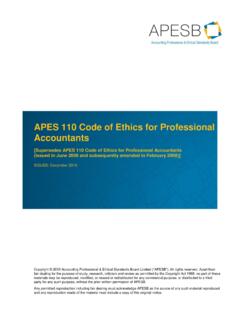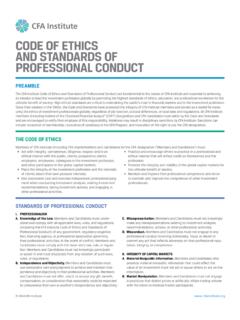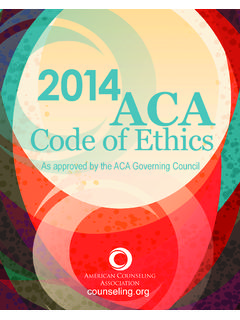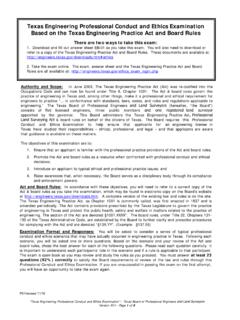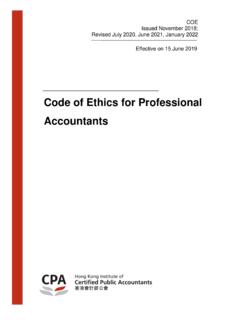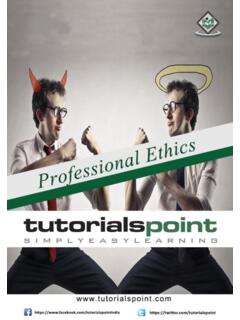Transcription of $3(6 &RGH RI (WKLFV IRU 3URIHVVLRQDO $FFRXQWDQWV …
1 APES 110 Code of ethics for professional Accountants (including Independence Standards). [Supersedes APES 110 Code of ethics for professional Accountants (Issued in December 2010 and amended in December 2011, May 2013, November 2013, May 2017 and April 2018)]. ISSUED: November 2018. Copyright 2018 Accounting professional & Ethical Standards Board Limited ( APESB ). All rights reserved. Apart from fair dealing for the purpose of study, research, criticism and review as permitted by the Copyright Act 1968, no part of these materials may be reproduced, modified, or reused or redistributed for any commercial purpose, or distributed to a third party for any such purpose, without the prior written permission of APESB.
2 Any permitted reproduction including fair dealing must acknowledge APESB as the source of any such material reproduced and any reproduction made of the material must include a copy of this original notice. APES 110 Code of ethics for professional Accountants (including Independence Standards) is based on the International Code of ethics for professional Accountants (including International Independence Standards) and the Final Pronouncement: Revisions to the Code Pertaining to the Offering and Accepting of Inducements of the International ethics Standards Board for Accountants (IESBA), published by the International Federation of Accountants (IFAC) in April 2018 and July 2018 respectively, and is used with permission of IFAC.
3 International Code of ethics for professional Accountants (including International Independence Standards) April 2018 by the International Federation of Accountants. Final Pronouncement: Revisions to the Code Pertaining to the Offering and Accepting of Inducements July 2018 by the International Federation of Accountants. Contact for permission to reproduce, store or transmit, or to make other similar uses of the International Code of ethics for professional Accountants (including International Independence Standards). CONTENTS. Page GUIDE TO THE CODE .. 3. CODE OF ethics FOR professional ACCOUNTANTS (INCLUDING. INDEPENDENCE STANDARDS) .. 9. SCOPE AND APPLICATION .. 12. GLOSSARY .. 13. PART 1 COMPLYING WITH THE CODE, FUNDAMENTAL PRINCIPLES AND.
4 CONCEPTUAL FRAMEWORK .. 24. PART 2 MEMBERS IN BUSINESS (INCLUDING EMPLOYMENT RELATIONSHIPS OF. MEMBERS IN PUBLIC PRACTICE) .. 37. PART 3 MEMBERS IN PUBLIC PRACTICE .. 68. INDEPENDENCE STANDARDS (PARTS 4A AND 4B). [AUST] PREFACE: PART 4A AND PART PART 4A INDEPENDENCE FOR AUDIT AND REVIEW ENGAGEMENTS .. 108. PART 4B INDEPENDENCE FOR ASSURANCE ENGAGEMENTS OTHER. THAN AUDIT AND REVIEW ENGAGEMENTS .. 177. TRANSITIONAL PROVISIONS .. 210. CONFORMITY WITH INTERNATIONAL PRONOUNCEMENTS .. 211. 2. GUIDE TO THE CODE. (This Guide is a non-authoritative aid to using the Code.). Purpose of the Code 1. The Code of ethics for professional Accountants (including Independence Standards) ( the Code ) sets out fundamental principles of ethics for Members, reflecting the profession's recognition of its public interest responsibility.
5 These principles establish the standard of behaviour expected of a Member. The fundamental principles are: integrity, objectivity, professional competence and due care, confidentiality, and professional behaviour. 2. The Code provides a conceptual framework that Members are to apply in order to identify, evaluate and address threats to compliance with the fundamental principles. The Code sets out requirements and application material on various topics to help Members apply the conceptual framework to those topics. 3. In the case of Audits, Reviews and other assurance engagements, the Code sets out Independence Standards, established by the application of the conceptual framework to threats to Independence in relation to these engagements.
6 How the Code is Structured 4. The Code contains the following material: Glossary, which contains defined terms (together with additional explanations where appropriate) and described terms which have a specific meaning in certain parts of the Code. For example, as noted in the Glossary, in Part 4A, the term Audit Engagement . applies equally to both Audit and Review Engagements. Part 1 Complying with the Code, Fundamental Principles and Conceptual Framework, which includes the fundamental principles and the conceptual framework and is applicable to all Members. Part 2 Members in Business (including employment relationships of Members in Public Practice), which sets out additional material that applies to Members in Business when performing professional Activities.
7 Members in Business include Members employed, engaged or contracted in an executive or non-executive capacity in, for example: o Commerce, industry or service. o The public sector. o Education. o The not-for-profit sector. o Regulatory or professional bodies. Part 2 is also applicable to individuals who are Members in Public Practice when performing professional Activities pursuant to their relationship with the Firm, whether as a contractor, employee or owner. Part 3 Members in Public Practice, which sets out additional material that applies to Members in Public Practice when providing professional Services. Independence Standards, which sets out additional material that applies to Members in Public Practice when providing assurance services, as follows: o Part 4A Independence for Audit and Review Engagements, which applies when performing Audit or Review Engagements.
8 3. o Part 4B Independence for Assurance Engagements Other than Audit and Review Engagements, which applies when performing Assurance Engagements that are not Audit or Review Engagements. 5. The Code contains sections which address specific topics. Some sections contain subsections dealing with specific aspects of those topics. Each section of the Code is structured, where appropriate, as follows: Introduction sets out the subject matter addressed within the section, and introduces the requirements and application material in the context of the conceptual framework. Introductory material contains information, including an explanation of terms used, which is important to the understanding and application of each Part and its sections.
9 Requirements establish general and specific obligations with respect to the subject matter addressed. Application material provides context, explanations, suggestions for actions or matters to consider, illustrations and other guidance to assist in complying with the requirements. How to Use the Code The Fundamental Principles, Independence and Conceptual Framework 6. The Code requires Members to comply with the fundamental principles of ethics . The Code also requires Members to apply the conceptual framework to identify, evaluate and address threats to compliance with the fundamental principles. Applying the conceptual framework requires exercising professional judgement, remaining alert for new information and to changes in facts and circumstances, and using the reasonable and informed third party test.
10 7. The conceptual framework recognises that the existence of conditions, policies and procedures established by the profession, legislation, regulation, the Firm, or the employing organisation might impact the identification of threats. Those conditions, policies and procedures might also be a relevant factor in the Member's evaluation of whether a threat is at an Acceptable Level. When threats are not at an Acceptable Level, the conceptual framework requires the Member to address those threats. Applying safeguards is one way that threats might be addressed. Safeguards are actions individually or in combination that the Member takes that effectively reduce threats to an Acceptable Level. 8. In addition, the Code requires Members to be independent when performing Audit, Review and other assurance engagements.

